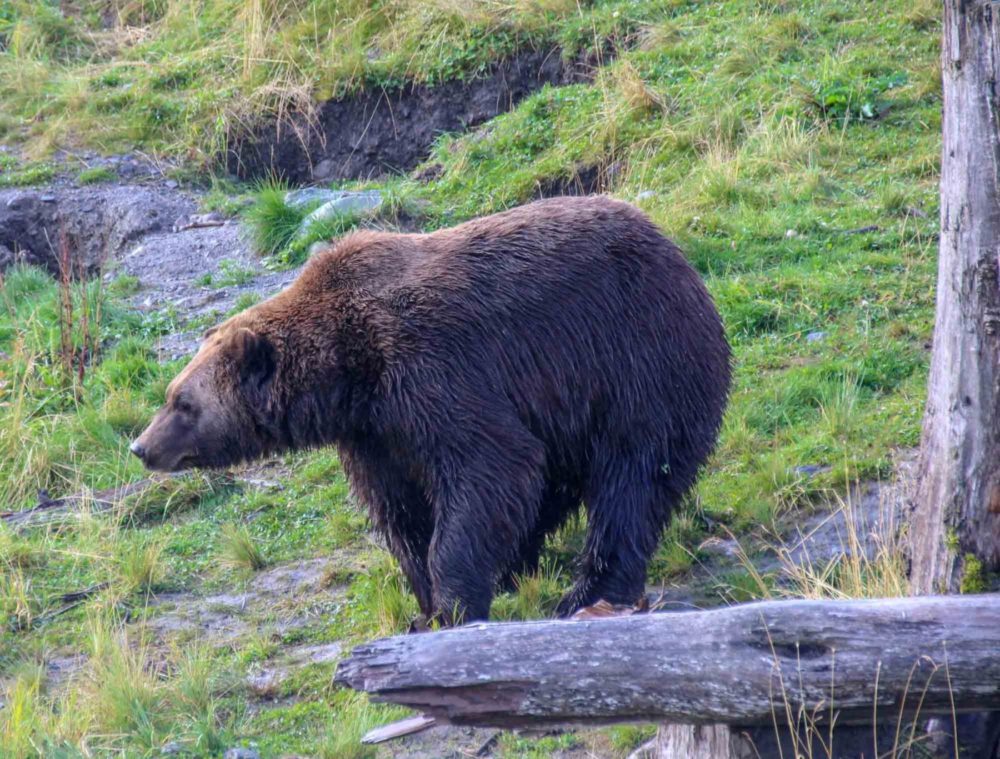Seeing wildlife in their natural habitat is why many people come to Alaska. As an Acupuncturist-at-Sea, I loved my seasons in Southeast Alaska and Inside Passage. I humbly share these photos as an amateur photographer, using my reliable Canon Rebel and Mirrorless EOS M50. I learned that wildlife photography is tricky and love the challenge of needing to act fast. In other words, wildlife sightings are unrehearsed, with no do-overs.
It’s good to know Alaska’s “Big 5”
Bear, Moose, Caribou, Wolf & Dall Sheep!
In Alaska, I always kept my camera by my side, usually ready for these unique wildlife shots. Overall, this photo story, showcases a variety of wildlife, such as, bears, humpback whales, orcas, seals, bald eagles, porcupines, sea otters, puffins and more with commentary.
Alaska Wildlife Photos – Bears and Moose
Most people go to Alaska hoping to see a bear. Alaska has 3 types of bears: the Brown, Black and Polar. However, in Southeast Alaska there are no polar bears. The best time to see these bears is May – September, especially while feeding on the salmon-filled streams. Also, the bears are thinner in spring, coming out of hibernation. Brown bears are larger than black bears, with an adult male weighing 300 to 650 pounds. In contrast, Grizzlies have well-developed shoulder muscles for digging and turning over rocks, which create a very distinctive shoulder hump.
Related: Fantastic Icy Strait Point’s Wildlife, Ziplining & Cultural Adventures
Whales, Orcas, Seals & Sea Otters
Humpbacks are migratory, moving up to 25,000 km (16,000 miles) each year. They eat only during half the year in cool waters, like Alaska and Antarctica. In SE Alaska, overall, about 600 humpbacks feed May through September, for up to 22 hours/day. This way they build their fat reserves to carry them through the breeding season in warmer waters, such as, Hawaii and Gulf of Mexico.
Related: Seeing the Awesome Humpback Whales of Alaska’s Inside Passage
Sea otters have the densest pelt of any animal. They don’t have blubber to keep warm, relying on their thick fur, and also eating helps them to keep warm. Furthermore, Sitka, Alaska was the fur trade capital in the 19th century, decimating the adorable sea otters to almost extinction. Now, the sea otter population remains threatened.
The tall dorsal fin of male orcas may be more than six feet tall. In comparison Females have a small triangular fin, like above photo. Also, Orca or Killer Whales are actually part of the Dolphin Family.
Ketchikan offers the Bering Sea Crab Fishing, aka “Deadliest Catch Crab Fishermen’s Tour”. The Aleutian Ballad crabbing vessel, as seen on the Discovery Channel’s Deadliest Catch, takes you on this expedition. Overall, this 3-hour scenic trip gives you real life perspective on the rigorous work of fishing for king crab and other seafood, such as, snow crab, octopus and prawns.
Related: Incredible Ketchikan, Alaska’s Top 10 Things to Do
More Alaska Wildlife Photos
The North American porcupine is one of the largest rodents in Alaska, second in comparison to the beaver. Furthermore, this stout, short-legged mammal is 25 to 31 inches (73-78 cm) long and covered with hair and quills of varying length.
Alaska Wildlife Photos – Raptors and Birds
Bald Eagles are found only in North America. These raptors are more abundant in Alaska than anywhere else in the United States. Overall, the Alaska population is estimated at 30,000 birds, with half of the world’s Bald Eagle population in Alaska. At 3-4 years of age, the Bald Eagle’s feathers begin to turn white on the head and tail. Their beak and eyes lighten in color as they reach adulthood.
Alaska’s Inside Passage and Tongass National Forest
Alaska’s Inside Passage is a water route between the Gulf of Alaska and Puget Sound. This popular Alaska route is known for its calm waters, rich history and spectacular scenery. Along the Inside Passage, visitors see countless wildlife in the land and sea. There are more than a thousand islands, pristine forests, dozens of glaciers and some of Alaska’s more remote ports, such as, Ketchikan, Juneau, Sitka, Icy Strait, Skagway and Haines.
The Tongass National Forest of Southeast Alaska is the largest national forest in the United States spreading over 17.6 million acres (68,000 km). In addition, it’s part of the Pacific Northwest Rainforest, as the Earth’s largest remaining temperate rainforest. Moreover, it’s named after the Tongass group of the Tlingit people, who inhabited this area. The forest is primarily made up of conifers, such as, western hemlock, red cedar and sitka spruce, along with various deciduous trees, mushrooms, ferns, lichens and mosses.
Read More!
Pristine Sitka, Alaska’s Top Ten Attractions
Alaska Travel Guides




















